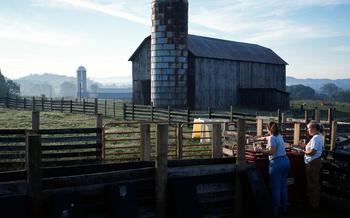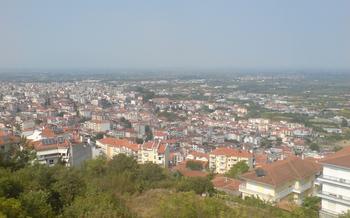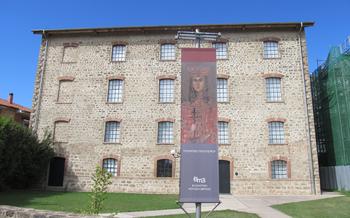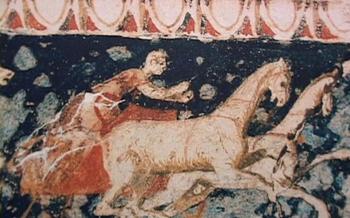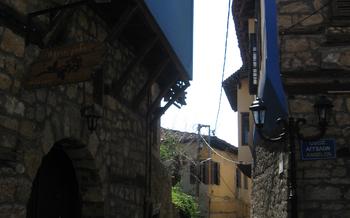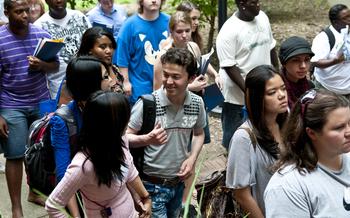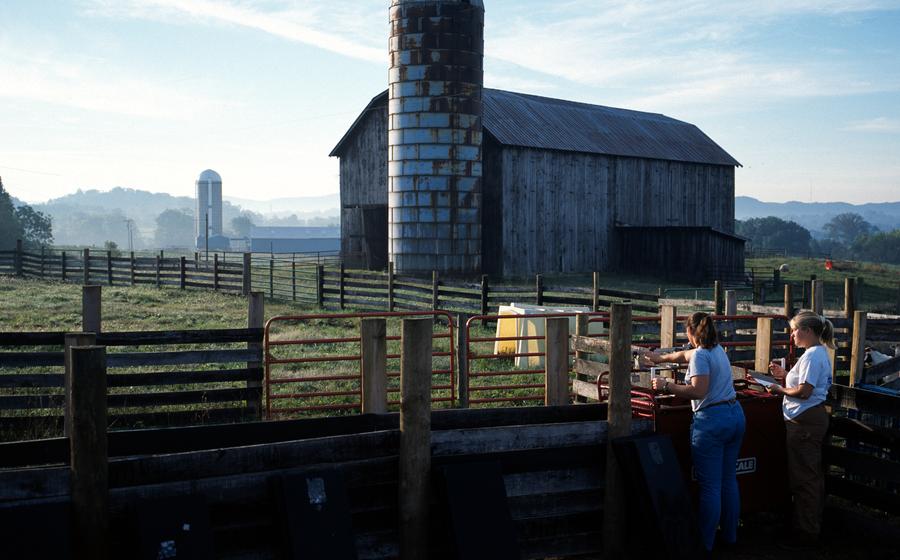
Modi of Veroia (Neolithic Settlement)
- History of the Modi of Veroia
- Location and Accessibility
- Entrance and Fees
- Artifacts and Exhibits
- Houses and Structures
- Religious and Ritual Practices
- Social and Economic Life
- Interactive Displays and Activities
- Surrounding Area and Attractions
- Best Time to Visit
- Tips for Visitors
- Accessibility and Facilities
- Educational Opportunities
- Local Cuisine and Restaurants
- Insider Tip
History of the Modi of Veroia
The Modi of Veroia, a Neolithic settlement of immense historical significance, was discovered in the 1960s during archaeological excavations led by renowned Greek archaeologist, Professor Nikolaos Moutsopoulos. These excavations unearthed a wealth of artifacts, shedding light on the lives of the Neolithic people who inhabited this region over 7,000 years ago. The discovery of well-preserved houses, workshops, and religious structures provided valuable insights into the social, economic, and cultural practices of this ancient community. The Modi of Veroia stands as a testament to the rich cultural heritage of Greece and offers a glimpse into the origins of human civilization in the region.
Location and Accessibility
The Modi of Veroia is situated in the city of Veria, in the region of Central Macedonia, in northern Greece. It is conveniently located just 70 kilometers from Thessaloniki, the second-largest city in Greece, making it an accessible day trip or a stop on a broader tour of the region.
To reach the Modi, visitors can take advantage of the excellent transportation options available in the area. By car, follow the E75 highway from Thessaloniki to Veria, and take the exit for the Modi, which is well-signposted. There is ample parking available at the site.
For those without a car, public transportation is a viable option. Buses run frequently from Thessaloniki to Veria, and from there, local buses or taxis can be taken to the Modi. The journey takes approximately two hours by bus.
Once at the Modi, visitors can explore the site at their own pace or opt for a guided tour. Guided tours are available in various languages and provide a deeper understanding of the history and significance of the Neolithic settlement.
Entrance and Fees
To step into the captivating world of the Modi of Veroia, visitors must pay a modest entrance fee. This fee helps support the preservation, maintenance, and further exploration of this significant historical site. The Modi's gates are open to the public during specific hours of operation, allowing ample opportunity for visitors to delve into the wonders of the Neolithic era.
Guided tours are available for those seeking a deeper understanding of the Modi's remarkable artifacts and structures. These tours, led by knowledgeable guides, provide insights into the lives of the Neolithic inhabitants, their customs, and the significance of their discoveries. Whether exploring independently or with a guide, visitors can immerse themselves in the Modi's rich history and gain a profound appreciation for this ancient settlement.
Artifacts and Exhibits
The Modi of Veroia showcases a remarkable collection of artifacts that provide valuable insights into the daily lives of the Neolithic inhabitants. These artifacts, unearthed during archaeological excavations, offer a glimpse into the technological advancements, artistic expressions, and cultural practices of this ancient settlement.
Tools and Weapons:
Among the most intriguing artifacts are the stone tools and weapons, including arrowheads, spearheads, and axes. These tools played a crucial role in hunting, gathering, and self-defense. The intricate craftsmanship and variety of these tools demonstrate the ingenuity and adaptability of the Neolithic people.
Pottery and Ceramics:
The Modi of Veroia is home to an extensive collection of pottery and ceramic vessels. These artifacts range from simple utilitarian pots to elaborately decorated vessels. The pottery provides valuable information about the culinary practices, storage techniques, and artistic traditions of the Neolithic inhabitants.
Jewelry and Ornaments:
The discovery of jewelry and ornaments, such as beads, pendants, and bracelets, attests to the aesthetic sensibilities of the Neolithic people. These artifacts, often made from semi-precious stones, shells, and bones, offer insights into their personal adornment and social status.
Insights into Neolithic Life:
Taken together, these artifacts provide a comprehensive picture of Neolithic life in Veria. They reveal the technological achievements, artistic expressions, and social customs of this ancient community, offering a fascinating glimpse into the foundations of Greek civilization.
Houses and Structures
The Modi of Veroia offers a glimpse into the architectural innovations of the Neolithic period. Visitors can explore reconstructed Neolithic houses, complete with thatched roofs, mud-brick walls, and simple furnishings. These structures provide insights into the daily lives and living conditions of the ancient inhabitants.
Fortified walls and gates, meticulously reconstructed using traditional techniques, showcase the advanced defensive capabilities of the settlement. These fortifications served to protect the community from potential threats and reflect the complexity of social organization during this time.
The excavated remains of houses and structures reveal evidence of community organization and daily life activities. Storage pits, hearths, and communal spaces provide clues about the division of labor, food preparation, and social interactions within the settlement.
Religious and Ritual Practices
Archaeological excavations at the Modi of Veroia have uncovered evidence of religious and ritual practices that provide insights into the spiritual beliefs of the Neolithic inhabitants. Altars and shrines have been identified, suggesting the existence of organized religious ceremonies. These structures were often decorated with symbols and motifs, possibly representing deities or sacred beings. Ritual objects, such as figurines, pottery vessels, and tools, have also been discovered, indicating the importance of ritual practices in daily life. These findings suggest that the inhabitants of the Modi had a complex religious system that was deeply intertwined with their social and cultural practices. The connection to the natural world and the elements played a significant role in their religious beliefs, as evidenced by the presence of altars and shrines located in prominent positions with views of the surrounding landscape.
Social and Economic Life
The Modi of Veroia offers a glimpse into the social and economic organization of the Neolithic settlement. Agriculture and farming were the primary sources of sustenance, with the cultivation of crops such as wheat and barley forming the basis of their diet. Animal husbandry played a significant role, with the raising of sheep, goats, and cattle providing a source of meat, milk, and wool.
Trade and commerce were essential aspects of life at the Modi. The settlement's strategic location facilitated the exchange of goods with neighboring communities. Pottery, tools, and other items were traded, fostering economic and cultural connections.
Social hierarchy and organization were evident within the community. The discovery of larger houses and specialized structures suggests the existence of elites or leaders who held positions of authority. The presence of communal spaces, such as plazas and meeting areas, indicates a sense of community and cooperation among the inhabitants.
The Modi of Veroia showcases the diverse social and economic aspects of Neolithic life, providing a comprehensive understanding of the community's daily activities and interactions.
Interactive Displays and Activities
To captivate visitors and enhance their understanding of Neolithic life, the Modi of Veroia incorporates interactive displays and activities. These engaging experiences bring history to life and make learning fun and immersive.
-
Hands-on Experiences: Visitors can participate in hands-on activities that simulate Neolithic tasks, such as grinding grain, weaving textiles, or crafting pottery. These experiences provide a tangible connection to the past and allow visitors to gain a deeper appreciation for the skills and ingenuity of our ancestors.
-
Educational Programs: The Modi offers educational programs tailored to different age groups and interests. These programs include guided tours, workshops, and demonstrations that delve into specific aspects of Neolithic life, such as hunting techniques, food preparation, or religious rituals.
-
Workshops and Demonstrations: Skilled artisans and historians conduct workshops and demonstrations that showcase traditional Neolithic crafts and techniques. Visitors can observe the creation of pottery, jewelry, and tools, gaining insights into the daily lives and artistic expressions of the Neolithic people.
-
Engaging Visitors with History: Through these interactive displays and activities, the Modi of Veroia fosters a deeper engagement with history. Visitors are encouraged to explore, question, and connect with the past, creating a memorable and educational experience that sparks a lifelong interest in archaeology and cultural heritage.
Surrounding Area and Attractions
Beyond the Modi of Veroia, the surrounding area offers a wealth of cultural and historical attractions. The Archaeological Museum of Veria, located in the city center, houses a rich collection of artifacts from various archaeological sites in the region, providing a deeper understanding of the region's ancient past.
For those interested in Byzantine history, Veria boasts several well-preserved churches, such as the Church of the Holy Apostles and the Church of Panagia Gorgoepikoos, showcasing exquisite architecture and intricate mosaics.
Nature enthusiasts can explore the scenic surroundings of Veria, with its lush forests and picturesque villages. Mount Vermion, with its enchanting hiking trails and panoramic views, is a popular destination for outdoor enthusiasts.
The region also hosts various cultural events and festivals throughout the year, celebrating local traditions and showcasing the vibrant cultural heritage of Veria. From traditional dance performances to culinary festivals, there is always something to experience and enjoy.
Best Time to Visit
The best time to visit the Modi of Veroia is during the shoulder seasons, from April to May and September to October, when the weather is mild and pleasant. During these months, the crowds are smaller, making it easier to explore the site at your own pace and take in the beauty of the surrounding landscape.
Summer months, from June to August, can be hot and crowded, especially during the peak tourist season. However, if you are visiting during this time, it is advisable to arrive early in the morning or late in the afternoon to avoid the heat and crowds.
The Modi of Veroia is also a great place to visit during the winter months, from November to March, when the site takes on a different character. The snow-capped mountains in the background create a picturesque setting, and the fewer visitors allow for a more intimate and atmospheric experience.
Special events and festivals are held throughout the year in Veria, which can make your visit even more memorable. In May, the city hosts the "Veroia Flower Festival," a celebration of spring with floral displays, music, and traditional dancing. In September, the "Veroia Byzantine Music Festival" showcases the rich musical heritage of the region with concerts and performances in churches and historical venues.
Tips for Visitors
Before embarking on your exploration of the Modi of Veroia, here are some essential tips for visitors:
-
Comfortable Footwear: The Modi is an extensive outdoor site, so comfortable and sturdy shoes are recommended for navigating the uneven terrain and cobblestone streets.
-
Sun Protection: The Greek sun can be intense, especially during the summer months. Bring sunglasses, a hat, and sunscreen to protect yourself from the sun's rays.
-
Hydration: Stay hydrated by bringing a reusable water bottle. There are no water fountains on the site, so it's important to come prepared, especially during hot weather.
-
Photography Guidelines: Photography is allowed at the Modi, but flash photography and tripods are not permitted. Respect the site and refrain from taking photos that may disturb other visitors or damage the artifacts.
Accessibility and Facilities
The Modi of Veroia is committed to providing an accessible and inclusive experience for all visitors. Accessibility features include:
-
Designated parking: There are dedicated parking spaces for visitors with disabilities located near the entrance.
-
Wheelchair ramps: The site is equipped with wheelchair ramps to ensure easy access for visitors with limited mobility.
-
Accessible restrooms: There are accessible restrooms located within the visitor center.
-
Audio guides: Audio guides are available in several languages and feature descriptions of the exhibits, making the site accessible to visitors who may be visually impaired.
-
Guided tours: Guided tours are available upon request and can be tailored to meet the needs of visitors with disabilities.
-
Information in various formats: Information about the Modi of Veroia is available in various formats, including large print, Braille, and audio recordings.
The Modi of Veroia strives to create an environment where everyone can learn about and appreciate the history and culture of this ancient site.
Educational Opportunities
The Modi of Veroia offers a wealth of educational opportunities for students, researchers, and the general public. School field trips are a popular way to introduce students to the wonders of Neolithic life and culture. The site's interactive displays, hands-on activities, and educational programs bring history to life for young learners.
Universities and research institutions often collaborate with the Modi to conduct archaeological excavations and research projects. The site's rich archaeological record and well-preserved artifacts make it an invaluable resource for scholars studying the Neolithic period.
The Modi also provides educational resources and programs for the general public. Guided tours and workshops offer visitors a deeper understanding of the site's history, culture, and significance. Educational materials, such as brochures, books, and online resources, are available to help visitors learn more about the Modi and the Neolithic period.
By preserving and sharing its historical knowledge, the Modi of Veroia plays a vital role in educating future generations about the origins of human civilization and the rich cultural heritage of Greece.
Local Cuisine and Restaurants
After exploring the fascinating history of the Modi, indulging in the local culinary delights is a must. Veria offers a diverse range of dining options, from traditional Greek tavernas to modern restaurants.
At the heart of Veria's cuisine lies the love for fresh, seasonal ingredients. Try the delicious paidakia (grilled lamb chops), moussaka (eggplant and potato casserole), and spanakopita (spinach and feta cheese pie). Don't miss the opportunity to savor the local specialty, giaourtlou (yogurt soup), a unique blend of flavors that will tantalize your taste buds.
For a truly authentic experience, visit one of the traditional tavernas in the old town. These cozy establishments offer a warm ambiance and a chance to interact with the locals. Be sure to sample the mezedes (appetizers), such as dolmades (stuffed grape leaves) and tzatziki (cucumber-yogurt dip), which perfectly complement the main dishes.
If you're looking for a more contemporary dining experience, Veria has several modern restaurants that offer creative interpretations of Greek cuisine. These establishments often incorporate international influences, resulting in innovative and exciting dishes.
No matter your preference, you're sure to find something to satisfy your palate in Veria. The city's culinary scene is as vibrant and diverse as its history, offering a feast for both the eyes and the taste buds.
Insider Tip
Unveiling the secrets of the Modi of Veroia is an adventure that goes beyond the ordinary exhibits and displays. To truly immerse yourself in the history of this Neolithic settlement, seek out the hidden gems that often go unnoticed by casual visitors. Explore the lesser-known corners of the site to discover remnants of ancient structures that reveal intriguing stories of the past. Venture off the beaten path and you might stumble upon secret spots that offer unique perspectives for capturing stunning photographs. Engage with the local guides and historians who can share insider knowledge and anecdotes that bring the Modi to life. With a bit of curiosity and exploration, you'll uncover the hidden treasures that make this archaeological site truly exceptional.
